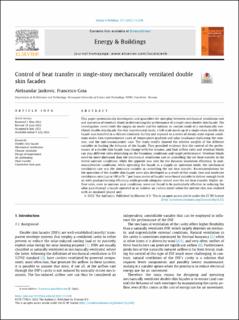| dc.contributor.author | Jankovic, Aleksandar | |
| dc.contributor.author | Goia, Francesco | |
| dc.date.accessioned | 2022-11-02T08:20:54Z | |
| dc.date.available | 2022-11-02T08:20:54Z | |
| dc.date.created | 2022-09-08T11:16:13Z | |
| dc.date.issued | 2022 | |
| dc.identifier.citation | Energy and Buildings. 2022, 271, . | en_US |
| dc.identifier.issn | 0378-7788 | |
| dc.identifier.uri | https://hdl.handle.net/11250/3029489 | |
| dc.description.abstract | This paper systematically investigates and quantifies the interplay between mechanical ventilation rate and operation of venetian blinds in determining the performance of a single-story double skin façade. The investigation covers both the supply-air mode and the outdoor air curtain mode of a mechanically ventilated double skin façade. For this experimental study, a full-scale mock-up of a single-story double skin façade was installed in a climate simulator facility and exposed to a series of steady-state regime conditions under two representative cases of temperature gradient and solar irradiance replicating the summer, and the mid-season/winter case. The study results showed the relative weights of the different variables in leading the behavior of the façade. They provided evidence that the control of the performance of a double skin façade may change with the seasons, and that airflow rates and venetian blinds can play different roles depending on the boundary conditions and target performance. Venetian blinds were far more dominant than the mechanical ventilation rate in controlling the net heat transfer in the tested summer conditions, while the opposite was seen for the dynamic insulation efficiency. In mid-season/winter conditions, while operating the façade in a supply-air operation mode, the mechanical ventilation rate was the dominant variable in controlling the net heat transfer. Recommendations for the operation of the double skin façade were also developed as a result of this study. Low and moderate ventilation rates (up to 100 m3h−1 per linear meter of façade) were found suitable to deliver enough fresh air with good preheating efficiency while provide adequate control over the net heat transfer. Higher airflow rates, even in summer peak conditions, were not found to be particularly effective in reducing the solar gain through a façade operated in an outdoor air curtain mode when the interior skin was realized with an insulated glazed unit. | en_US |
| dc.language.iso | eng | en_US |
| dc.publisher | Elsevier Science | en_US |
| dc.rights | Navngivelse 4.0 Internasjonal | * |
| dc.rights.uri | http://creativecommons.org/licenses/by/4.0/deed.no | * |
| dc.title | Control of heat transfer in single-story mechanically ventilated double skin facades | en_US |
| dc.title.alternative | Control of heat transfer in single-story mechanically ventilated double skin facades | en_US |
| dc.type | Peer reviewed | en_US |
| dc.type | Journal article | en_US |
| dc.description.version | publishedVersion | en_US |
| dc.source.volume | 271 | en_US |
| dc.source.journal | Energy and Buildings | en_US |
| dc.identifier.doi | 10.1016/j.enbuild.2022.112304 | |
| dc.identifier.cristin | 2049855 | |
| dc.relation.project | Norges forskningsråd: 262198 | en_US |
| dc.source.articlenumber | 112304 | en_US |
| cristin.ispublished | true | |
| cristin.fulltext | original | |
| cristin.qualitycode | 2 | |

